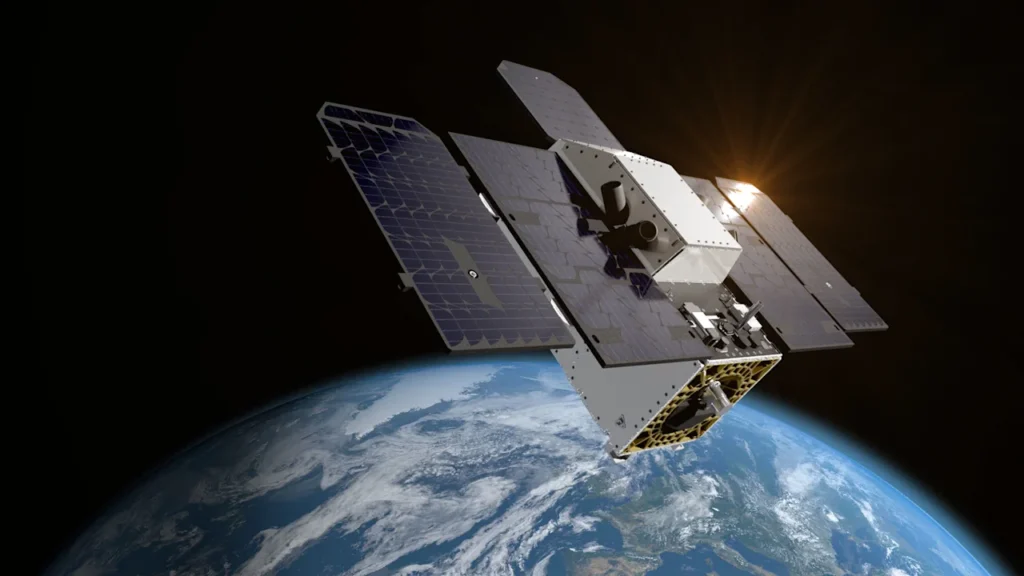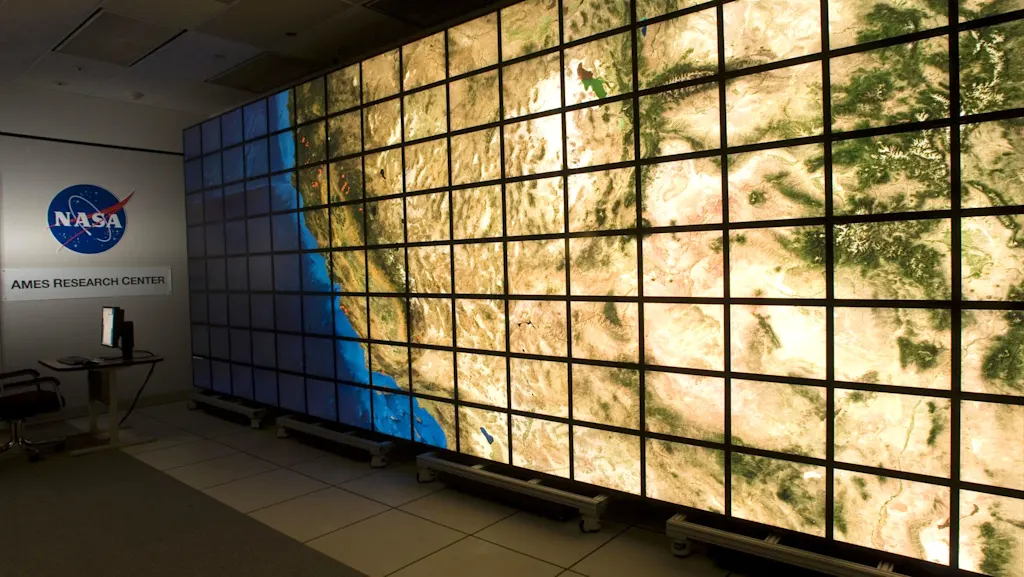
Daniel P. Johnson, a geographer at Indiana University at Indianapolis, works with a team of researchers who spend a lot of time catching blowflies, dissecting their iridescent blue-green abdomens, and analyzing the contents of their guts.
Johnson and his colleagues are tracking the spread of Lyme disease on a warming planet. But they need a lot of additional data. They get it from NASA.
The world’s foremost driver of space science is not a public health agency. But NASA’s vast data collection has quietly become important for health research, helping scientists track disease outbreaks and monitor air pollution amid climate change.
Now, as President Donald Trump’s administration proposes sweeping cuts to the agency’s budget, including its Earth Sciences Division, experts are worried that many of these data sources could be lost, and research collaborations halted, with serious consequences for public health.
NASA “really enabled a whole new world of health research that the public health community hadn’t been doing yet,” said Susan Anenberg, who directs the George Washington University Climate and Health Institute, and whose own work has been funded by NASA for nearly a decade.
NASA, of course, is best known for launching expeditions into space and capturing images of distant galaxies. But NASA also has a mission to Earth. Its satellites surveil what the agency calls “vital signs of the planet” and supply information to scientists whose work is decidedly Earthbound.
A good deal focuses on tracking the effects of climate change on groundwater levels, wildfires, global temperature trends, and more. Those changes come with health hazards, and research funded by NASA or supported by NASA data has helped scientists study the effect of environmental changes on malaria, avian flu, asthma, and other respiratory and cardiovascular diseases, as well as cognitive decline in the elderly and preterm birth, both of which can be affected by heat.
The space agency also tracks air pollution and particulate matter, which isn’t all caused by global warming, though a warmer planet may make some health hazards of pollution more severe and complex. That interaction is part of what scientists are using NASA data to better understand.
In the case of the blowflies, Johnson and his team are using NASA data to track the spread of Lyme. Blowflies feed on fecal matter and decomposing meat, including that of white-footed mice, which are a reservoir for the bacteria that cause Lyme disease. If there’s a lot of white-footed mouse DNA in the flies’ guts, it suggests there are a lot of those mice around, which in turns offers some signal about the prevalence of Lyme. (At one point, his team found tiger and elephant DNA in fly guts, which was puzzling—until the researchers remembered that the Indianapolis Zoo was nearby.)
Lyme disease is tick-borne, and the ticks bite mice and then bite humans. By tracking the mice via the blowfly guts, Johnson and his team aim to create a rough map of where Lyme is present and how it’s moving across the landscape. To fill in that map, Johnson relies on NASA data about the physical environment—the landscape, meteorological conditions, air temperatures, and incoming solar radiation values. The result, he hopes, will inform Indiana’s public health officials’ efforts to reduce the spread of Lyme—and with time, contribute to a broader understanding about this tick-borne disease on a warming planet.
In addition to tracking the disease locally, Johnson and other scientists are looking at how climate change could make Lyme more prevalent, and possibly, as some data suggests, more infectious.
Johnson received NASA funding in 2008 to study early strategies to protect urban areas during heat waves. Now, he’s hoping to get a NASA grant to continue his Lyme research, still in its early stages. Without it, continuing this work, now backed by his university and local health departments, would be more difficult over the long haul.
The geographer is one of many researchers and policymakers who have benefitted from a focus within NASA on examining conditions on Earth. “We have a constellation of over 20 satellites and sensors in Earth’s orbit, including several on board the International Space Station, that are continuously monitoring Earth’s weather, climate, and environment for research and applications purposes,” John Haynes, a meteorologist and program manager in NASA’s Earth Science Division, said on a NASA broadcast last year.
“We get a ton of data on the Earth’s system, and how it is changing, downloaded every day from that constellation. And that data gives us information on things like land surface temperature, ocean surface temperature, vegetation density, air pollution, wildfires, you name it,” Haynes added.
That “ton of data,” he said, is almost 25 terabytes every day.
NASA makes data available at no charge to researchers and to federal, state, and local public health agencies in the United States, and around the globe. A lot of Anenberg’s work at George Washington University involves making some of that data more accessible, she said. NASA has wanted it to reach “people in local government, people in school boards, people in any walks of life.” Her group, she said, has created several websites, one of which allows users to look up local levels of fine particulate matter or carbon dioxide, or example, and compare it to cities elsewhere.
The future of some of that public health work is now unclear.
The Trump administration’s proposed budget for the coming fiscal year would, if enacted, bring NASA’s spending back to 1961 levels, with cuts to science divisions including Earth science tantamount to an “extinction-level event,” according to a piece by Asa Stahl, science editor for The Planetary Society, a nonprofit that advocates for space science and exploration. The overall budget would be cut by nearly 25%, and Earth science more than halved.
The White House has described these cuts as an attempt to refocus NASA on space exploration by prioritizing missions to the Moon and Mars.
In May, NASA closed a New York office that housed the Goddard Institute for Space Studies lab, part of the agency dedicated to studying climate change and other Earth sciences. The researchers who worked at that site weren’t fired, but a brain drain of NASA scientists has begun and may well accelerate.
As of late July, nearly 4,000 NASA staff had opted for early retirements and similar arrangements, according to a statement from the agency. The number of departures may still rise. “[T]he last six months have seen rapid and wasteful changes which have undermined our mission and caused catastrophic impacts on NASA’s wokforce,” a group of current and former agency employees wrote in a recent open letter.
NASA’s chief scientist and senior climate adviser, Katherine Calvin, was let go earlier this year.
“The cutting-edge science taking place at NASA has far-reaching societal benefits, more than many people are aware. The climate crisis is a public health crisis, and fighting these crises will not happen in a vacuum,” Rep. Zoe Lofgren, the top Democrat on the House Science, Space, and Technology Committee, wrote to Undark in an emailed statement.
“Unleashing chaos on the agency by gutting science programs, firing employees without cause, and proposing draconian budget cuts for NASA,” she added, “will hurt Americans and jeopardize the future of our rising generations.”
Several NASA spokespeople, as well as Haynes and other scientists at the agency, as well as House and Senate Republicans involved with space policy, did not respond to requests for interviews, or referred Undark to public budget documents. In a brief emailed statement, NASA press secretary Bethany Stevens said the agency “remains committed to our mission as we work with a more prioritized budget.” She did not address how proposed cuts could affect environmental data and public health work. The Centers for Disease Control and Prevention, which has partnered with NASA on climate research, also did not comment.
While Republican lawmakers have mostly endorsed the Trump administration’s overall vision for the agency, Congressional appropriators have approved spending bills that would largely leave NASA’s funding intact. But the Trump administration has withheld money appropriated by Congress in other agencies, and presidential appointees have made clear they plan to keep doing so.
Some conservative policy thinkers champion a dramatic realignment of NASA spending. “My view is that NASA should not be chasing climate, period,” said Anthony Watts, a senior fellow of the Heartland Institute, a think-tank known for arguing that climate change is not a crisis. It’s fine if NASA launches satellites for the National Oceanic and Atmospheric Administration or the U.S. Geological Survey, he said, but “NASA should concentrate on space and space missions.”
NASA used to widely promote its climate and public health work. The agency had a presence at last year’s American Public Health Association conference, complete with a big high-definition video screen the agency calls its “hyperwall,” which illustrates how researchers can draw on NASA data to map, for instance, where water-borne diseases are likely to emerge.
In recent years, the public health work has become more varied and more urgent, touching both global and domestic health. “There’s a lot of possibility for conducting public health research with NASA data and tools, ” said Anenberg, the George Washington University researcher. “And the reason the field exists the way it does now, with a lot of people doing that research, is because of support from NASA.”

But it requires money. And if those funds get cut as deeply as the White House has proposed, the impact could be vast. It’s not yet clear, though, precisely which specific programs within Earth sciences could be axed—though firing the top climate scientist may be a signal. So, too, might recent news that the Trump administration is moving to have NASA decommission two satellites that gather information on greenhouse gases.
Many scientists and public health experts want earth science and health research to remain squarely within NASA’s mission.
NASA satellite imagery, for example, has been used to develop tools that can predict cholera outbreak risks in countries like Bangladesh. Health teams can mobilize to avert or minimize illness.
NASA data has also been used to study malaria, which is widespread, often seasonal, and endemic in many parts of the world. As the climate changes and rainy spells and dry spells shift, the timing and contours of the malaria season are changing, said Richard Steketee, who spent 25 years at the CDC, mostly working on malaria. That adds an unwelcome amount of guesswork for health teams that need to know where and when to preposition the bed nets, insecticide, and prophylactic drugs. Mapping those changes is complex, but NASA satellites and computer modeling can help, said Steketee, who served as deputy coordinator for the U.S. President’s Malaria Initiative in his final five years at the CDC before retirement.
The focal point for much of the work in the last few years is NASA’s Health and Air Quality Applied Sciences Team, or HAQAST. The research cohort, consisting of scientists from within and outside NASA, is led by Tracey Holloway, a professor of energy analysis and policy at the University of Wisconsin-Madison.
Recently, Holloway has been studying how to best utilize satellite data to fill in environmental health knowledge gaps in rural areas, given that many counties don’t even have a single ground-based monitor to track ozone, fine particulate matter, and other pollutants. In public health, “more information can lead to better risk characterization, better forecasts, better outreach,” she said in an interview. That includes better tracking of wildfire smoke with satellite data to support emergency public health response.
Funding for the current round of HAQAST work was approved by the Trump administration this year, with the “goal of connecting NASA with private- and public-sector information needs,” Holloway wrote in a follow-up email. But there are no guarantees, she wrote, and no alternative source of financial support.
Drew Shindell, a professor of Earth science at Duke’s Nicholas School of the Environment, has both worked at NASA and been funded by NASA as a grantee. Over 30-plus years, his own professional trajectory has aligned with the growing urgency of the climate crisis.
Originally a researcher of the stratosphere, he has shifted his work to focus on modeling climate change, including its impacts on health. When connections between public health and this kind of research came up, he recalled, there were people both within NASA and on the Hill who didn’t think that was NASA’s job, that it was mission creep.
While Shindell agreed that NASA’s work in this area should be coordinated with other agencies to avoid duplication, he disagreed with any arguments that NASA shouldn’t be involved in such research at all. In part, the desire to study health, as well as his increasing interest in looking at the economic impact of climate change, propelled him to move to an academic setting at Duke. He still uses NASA data, NASA computers, and NASA supercomputers to model the effects of a warming world.
He and his colleagues develop scenarios and do physical science in order to model those scenarios’ impact on climate, health, and economies. In the academic world, he can work on that whole continuum in a way he could not had he remained at NASA.
And now, whether even that work can continue may be uncertain.
Joanne Kenen is the Journalist in Residence at the Johns Hopkins Bloomberg School of Public Health, where the Kresge Foundation supports her work on climate and health. Earlier, she spent a decade overseeing health coverage at Politico. This story originally appeared at Undark.



